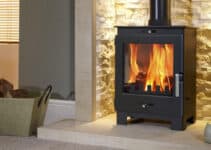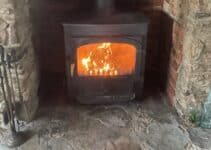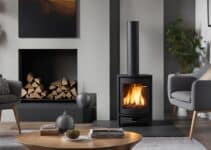When it comes to selecting the right type of firewood for one’s log burner, the conversation often turns to the merits and drawbacks of different timbers. In my experience as a seasoned user of wood burners, the question frequently arises: can you use poplar wood in a log burner? There’s a certain controversy that surrounds the use of poplar firewood due to its characteristic as a soft and lightweight wood, yet I find it imperative to explore its potential comprehensively.
Burning poplar wood does indeed present a contrasting profile to the more substantial hardwoods. While woods like oak or maple might provide a prolonged and dense heat, poplar tends to combust rapidly and produces a more modest heat output. Nonetheless, for those who find themselves with an abundance or an opportunity to acquire poplar at a low cost, it can serve efficiently during milder weather or as an element in a mixed-wood scenario within a log burner.
Through anecdotal testimony, many individuals, myself included, recommend it as excellent kindling or as an adjunct to morning coals to quickly and effectively rouse a fire back into life. Despite the rapid burn rate and its propensity to pop, its contribution to a strategic approach to fire management should not be underestimated.
Whether out of necessity or preference, incorporating poplar wood in a log burner demands a nuanced understanding of its properties and a readiness to employ it judiciously. My intention is to delve into this lesser-acknowledged resource and shed light on its capabilities and best use within our homes’ hearths.
Understanding the Properties of Poplar Wood in a Log Burner
When I investigate whether poplar logs can be burned in a log burner, I hone in on the specific attributes that distinguish poplar from more traditional firewood choices. Poplar trees such as aspen and cottonwood are lauded for their swift growth and towering stature, qualities which make them a prevalent selection for decorative planting and industrial utilisation in sectors like paper manufacturing.
Crucially, as a log burner for poplar, one should anticipate a modest BTU (British Thermal Unit) yield. This essentially denotes the energy released when the wood combusts – a vital factor for determining the log burner’s efficiency. Nevertheless, poplar’s quick ignition ability and the lower density make it a feasible, albeit less conventional, option for log burner enthusiasts.
Let’s not overlook the ease with which one can handle poplar. Compared to sturdier counterparts, the softness of poplar wood means processing it for use is a straightforward task. Nevertheless, as a poplar log burner, one ought to prepare for more frequent restocking, given poplar’s rapid combustion pace and shorter-lived heat emissions.
Despite its limitations in heat retention, the copious availability and swift regeneration of poplar ensure its viability as a supplementary firewood, especially for those seeking sustainable options.
For a deeper understanding, I’ve charted a comparison of poplar’s fundamental properties against more traditional hardwoods:
| Wood Type | BTU Output | Burn Time | Processing Ease |
|---|---|---|---|
| Poplar | Lower | Quicker | High |
| Oak | Higher | Longer | Moderate |
| Maple | Higher | Longer | Moderate |
In summary, while the poplar may not claim the throne for the longest-lasting burn or the most intense heat output, its other strengths present a reasonable argument for its inclusion in a log burner’s repertoire. And so, I find myself contemplating, as I cast my eye over the flickering flames within my own hearth – can poplar logs be burned efficiently? Indeed, they can, though perhaps best when amalgamated with denser woods to offset their ephemeral heat offering.
Comparing Poplar to Traditional Firewood Types
As a connoisseur of log burner wood types, I have often been asked about the best wood for log burner use. Undoubtedly, understanding the nuanced differences between various wood types is crucial for anyone wishing to optimise their log burner’s performance. Within this realm, a frequent point of discussion is the burning properties of poplar wood compared to more traditional firewood options.
Hardwoods vs. Softwoods
Beginning with the basics, hardwoods and softwoods are categorised by their botanical lineage rather than their actual hardness. Poplar, for instance, although classified as a hardwood, demonstrates characteristics akin to softwoods, such as a speedier burn rate. This fundamental understanding is critical when comparing poplar to other hardwoods that are typically sought after for their slow-burning qualities and higher energy outputs.
Heat Output and Burn Duration of Poplar
When choosing the best wood for a log burner, heat output and burn duration are paramount. Poplar, due to its less dense nature, tends to produce a bright flame that cost the space with warmth rather quickly but does not sustain it for long. Let’s delve into the specifics of how poplar’s heat release compares to that of denser hardwoods like oak or hickory.
Poplar’s Density and Moisture Content
With a notably lower density, poplar presents a higher consumption rate to achieve the same calorific output as heavier woods. This intrinsic property aligns with its moisture content; poplar dries faster and ignites more readily, but it also means a shorter fireplace experience. For those eschewing the traditional wood types for log burners in favour of this lighter alternative, such differences are essential to consider for heating efficiency and fuel stock planning.
| Wood Type | Density (lbs/ft³) | Moisture Content (%) | BTU per Cord | Burn Duration |
|---|---|---|---|---|
| Oak | 52-77 | 20-30 | 22-24 million | Long |
| Hickory | 58-87 | 20-30 | 24-27 million | Very Long |
| Poplar | 22-31 | 15-25 | 13-15 million | Short |
To summarize, while poplar may not conventionally top the list of premium log burner wood types due to its expedited burn time and lower heat output, it holds its value in specific scenarios. It is at its most effective when used in combination with denser hardwoods or as an easy-to-light kindling in one’s log burner. This strategic approach allows one to reap the benefits of poplar’s unique characteristics whilst balancing out its limitations.
Practical Tips for Burning Poplar Logs in Your Log Burner
When I contemplate utilising poplar firewood, certain measures ensure a satisfactory burn, particularly in a log burner. Many may ponder, “Can you burn poplar in a log burner?” and the answer, definitively, is yes, although with some strategic considerations. The transitional seasons are prime times for poplar, where the demand for heat is not as taxing, allowing this fast-burning species to shine without rapid depletion.
My experience has shown that the splitting quality of poplar wood is outstanding, fostering swift fire-starting. This translates into poplar serving exceptionally as kindling, which lights quickly and brings the fire to a respectable level with ease. Below are further insights I’ve compiled.
- Mixing Woods – When burning poplar alone is not enough, mingling it with hardwoods can noticeably enhance the burn duration and overall thermal output.
- Seasoning – A well-seasoned log of poplar is a clean-burning source, demanding a fraction of the seasoning time compared to other wood types, making it relatively fuss-free.
- Storage – I cannot stress enough the importance of proper wood storage; keeping poplar logs off the ground and under cover is vital to avoid moisture’s return, assuring that the logs burn effectively when called upon.
Here’s a table that summarises my practical tips:
| Tip | Description | Benefit |
|---|---|---|
| Mixing Woods | Combine poplar with denser hardwoods for a sustained burn. | Extended burn time, improved heat output. |
| Seasoning | Allow poplar to season for a shorter period compared to hardwoods. | Reduces smoke and ensures a cleaner burn. |
| Storage | Store poplar off the ground and shielded from rain. | Prevents reabsorption of moisture for a more efficient burn. |
In conclusion, with these practical approaches, your experience with poplar in a log burner can be as rewarding as with traditional firewoods.
Can You Burn Poplar in a Log Burner?
As a seasoned user of log burners, I’ve encountered various log burner wood types throughout my experiences. Key among the types is poplar—often considered for use in log burners. As we venture into evaluating poplar wood in log burners, it is necessary to consider both its efficiency and safety, as well as tips for optimising its use.
Efficiency and Safety Considerations
My journey with burning poplar logs has taught me that while they can be burned, they offer a unique set of considerations. The efficiency of poplar often comes into question due to its rapid combustion rate. This characteristic necessitates frequent reloading, a factor to weigh if you prefer a maintenance-free evening by the hearth. On the safety front, I appeciate that poplar comes with a low risk of creosote formation, making it a safer choice compared to other resinous woods that can congest the chimney over time. Yet, it’s not without its quirks; the wood is somewhat notorious for producing sparks, prompting me to recommend the use of protective screens for those with an open-faced log burner.
Mixing Poplar with Other Woods for Optimal Use
One of the effective strategies I’ve found for utilising poplar wood is in combination with other denser woods. When I mix poplar with logs that have a higher BTU output, like oak or maple, I find that I’m able to create a balanced, sustained burn. This blend capitalises on the quick ignition properties of poplar and the lasting heat provided by the hardwoods. Such a practice not only improves the burn efficiency but also extends the usability of your firewood supply, making poplar an integral part of a strategic approach to wood burning in a log burner.
Conclusion
As I draw this discussion to a close, it’s evident that while not the superior choice for fuel, poplar has a place in the realm of log burners. The question, ‘can you burn poplar in a log burner’, is met with an affirmative, albeit with certain caveats. Its abundant growth and cost-effectiveness present it as a practical, albeit not ideal, source of fuel for those who require it. With proper strategy, such as utilising a mix of woods, the less desirable traits of poplar can be mitigated.
True, poplar’s brisk combustion and lower energy output render it a less favoured wood for those seeking sustained warmth from their log burner. Yet, its utility as effortless kindling cannot be discounted; poplar is undeniably proficient at initiating a fire. Therefore, for the individual equipped with a ready supply of this wood, it’s worth integrating poplar into a firewood strategy that maximises heat efficiency during cooler seasons or when temperatures are temperate.
To optimise your fire, employing a mixed wood approach remains the best practice, elevating poplar beyond its singular limitations. By doing so, one can enjoy the benefits of a robust fire, sustained heat, and safety – attributes that align with the best wood for log burner recommendations. Ultimately, poplar has its role, especially when judiciously combined with other hardwoods, to create a dynamic, efficient and versatile burning experience.



